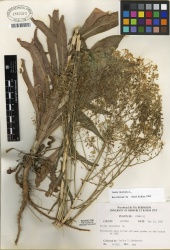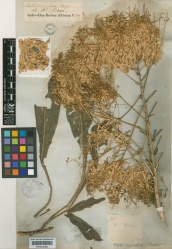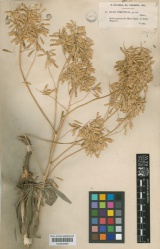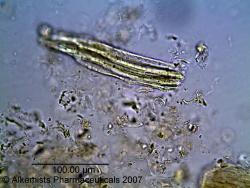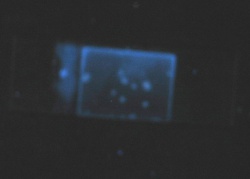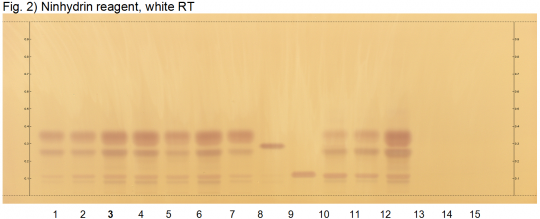Isatis tinctoria (root)
(addition of hptlc info.--jd) |
(correct formatting) |
||
| (8 intermediate revisions by 3 users not shown) | |||
| Line 1: | Line 1: | ||
| − | = | + | {{DISPLAYTITLE:''Isatis tinctoria'' (root) }} {{askbox|herb=''Isatis tinctoria''}} |
| − | =Macroscopic | + | =Nomenclature= |
| − | =Microscopic | + | |
| − | {{Microscopy | source=Elan M. Sudberg, Alkemist Laboratories | + | {{nomenclature | binomial=Isatis tinctoria |
| + | |authority=L. | ||
| + | |family=Brassicaceae | ||
| + | |scn=dyer's woad | ||
| + | |syn= | ||
| + | |ayurvedic= | ||
| + | |pinyin= | ||
| + | |aka=woad | ||
| + | |notes= }} | ||
| + | |||
| + | =Botanical Voucher Specimen= | ||
| + | |||
| + | {{Media3 |cat=Voucher | ||
| + | |||
| + | | source=MOBOT, Tropicos.org | ||
| + | | mainimage=Isatis_tinctoria_Tropicos_100002111.jpg | ||
| + | | companyimage=TropicosLogo.gif | ||
| + | | companyURL=http://www.tropicos.org/Image/100002111 | ||
| + | | reference=Tropicos.org. Missouri Botanical Garden. 25 Mar 2014 <http://www.tropicos.org/Image/100002111> | ||
| + | |||
| + | |||
| + | | source2=Royal Botanic Gardens, Kew. | ||
| + | | companyimage2=Kewlogo.gif | ||
| + | | companyURL2=http://specimens.kew.org/herbarium/K000642883 | ||
| + | | image2=Isatis_tinctoria_subsp._corymbosa_Kew_imageBarcode%3DK000642883_287197.jpg | ||
| + | | caption2=''Isatis tinctoria'' subsp. ''corymbosa'' | ||
| + | |||
| + | |||
| + | | source3=Royal Botanic Gardens, Kew. | ||
| + | | companyimage3=Kewlogo.gif | ||
| + | | companyURL3=http://specimens.kew.org/herbarium/K000642882 | ||
| + | | image3=Isatis_tinctoria_subsp._tomentella_Kew_imageBarcode%3DK000642882_287196.jpg | ||
| + | | caption3=''Isatis tinctoria'' subsp. ''tomentella'' | ||
| + | |||
| + | | }} | ||
| + | |||
| + | =Organoleptic Characteristics= | ||
| + | {| border=1 | ||
| + | | | ||
| + | {{Organolepsy | source=United States Dispensatory (1918) | ||
| + | | description=[''Isatis tinctoria'' has] leaves [of] a fugitive, pungent odor, and an acrid, very persistent taste...}} | ||
| + | |} | ||
| + | |||
| + | =Macroscopic Characteristics= | ||
| + | =Microscopic Characteristics= | ||
| + | {{Media2 |cat=Microscopy | source=Elan M. Sudberg, Alkemist Laboratories | ||
| companyimage= AP-LOGO-Laboratories Crop - Copy.jpg | | companyimage= AP-LOGO-Laboratories Crop - Copy.jpg | ||
| − | | companyURL=http://www. | + | | companyURL=http://www.alkemist.com |
| mainimage=Isatis tinctoria - Alkemist Laboratories.jpg | | mainimage=Isatis tinctoria - Alkemist Laboratories.jpg | ||
| caption1=Yellow fibers observed at 400x with Acidified Chloral Hydrate Glycerol Solution. | | caption1=Yellow fibers observed at 400x with Acidified Chloral Hydrate Glycerol Solution. | ||
| − | | | + | | source2=Elan M. Sudberg, Alkemist Laboratories |
| + | | companyimage2= AP-LOGO-Laboratories Crop - Copy.jpg | ||
| + | | companyURL2=http://www.alkemist.com | ||
| image2=Isatis tinctoria-1 - Alkemist Laboratories.jpg | | image2=Isatis tinctoria-1 - Alkemist Laboratories.jpg | ||
| caption2=Slide after preparation under UV 365 nm showing blue fluorescence observed at 400x with Acidified Chloral Hydrate Glycerol Solution. | | caption2=Slide after preparation under UV 365 nm showing blue fluorescence observed at 400x with Acidified Chloral Hydrate Glycerol Solution. | ||
| Line 14: | Line 61: | ||
| − | = | + | =High Performance Thin Layer Chromatographic Identification= |
{{HPTLC | source=HPTLC Association | {{HPTLC | source=HPTLC Association | ||
| companyimage=HPTLC-assoc-Logo-farbig-Text-schwarz-300x47.png | | companyimage=HPTLC-assoc-Logo-farbig-Text-schwarz-300x47.png | ||
| Line 51: | Line 98: | ||
| }} | | }} | ||
| − | + | =Supplementary Information= | |
| − | + | =Sources= | |
| − | + | <references /> | |
| − | + | ||
| − | + | ||
| − | + | ||
| − | + | ||
| − | + | ||
| − | + | ||
| − | + | ||
| − | + | ||
| − | + | ||
| − | + | ||
| − | + | ||
| − | + | ||
| − | + | ||
| − | + | ||
| − | + | ||
| − | + | ||
| − | + | ||
| − | + | ||
| − | + | ||
| − | + | ||
| − | + | ||
| − | + | ||
| − | + | ||
| − | + | ||
| − | + | ||
| − | + | ||
| − | + | ||
| − | + | ||
| − | + | ||
| − | + | ||
| − | + | ||
| − | + | ||
| − | + | ||
| − | + | ||
| − | + | ||
| − | + | ||
| − | + | ||
| − | + | ||
| − | + | ||
| − | + | ||
| − | + | ||
| − | + | ||
Latest revision as of 02:41, 25 March 2015
Contents |
Nomenclature
Isatis tinctoria L. Brassicaceae
Standardized common name (English): dyer's woad
Botanical Voucher Specimen
 |
 |
|
|
|
|
|
Organoleptic Characteristics
|
Macroscopic Characteristics
Microscopic Characteristics
 |
 |
|
|
|
High Performance Thin Layer Chromatographic Identification
|
Isatis (root) (Isatis tinctoria) Lane Assignments Lanes, from left to right (Track, Volume, Sample):
Reference Sample(s) Reference: Dissolve 4 mg of L-arginine monohydrochloride in 1 mL of ethanol 70%. Dissolve 4 mg of L-cysteine hydrochloride monohydrate in 1 mL of ethanol 70%. Stationary Phase Stationary phase, i.e. Silica gel 60, F254 Mobile Phase Acetonitrile, water, formic acid 30:8:2 (v/v/v) Sample Preparation Method Sample: Mix 500 mg of powdered sample with 5 mL of ethanol 70% and sonicate for 10 min, then centrifuge or filter the solutions and use the supernatants / filtrates as test solutions. Derivatization reagent: Before derivatization, treat plate with ammonia 25% vapor for 5 min.; Ninyhdrin reagent; Preparation: Dissolve 0.6 g of ninhydrin in 190 mL of isopropyl alcohol (2-propanol) and add 10 mL of glacial acetic acid; Use: Dip (time 0, speed 5), heat at 120°C for 3 min. Detection Method Saturated chamber; developing distance 70 mm from lower edge; relative humidity 33% Other Notes Images presented in this entry are examples and are not intended to be used as basis for setting specifications for quality control purposes. System suitability test: L-Cysteine hydrochloride monohydrate: a brown zone at Rf ~ 0.29; L-Arginine monohydrochloride: a brown zone at Rf ~ 0.12. Identification: Compare result with reference images. The fingerprint of the test solution is similar to that of the corresponding botanical reference sample. Additional weak zones may be present. The chromatogram of the test solution shows a brown zone (Rf ~ 0.12) at the position of reference arginine. Right below it there is another faint brown zone. There is a brown zone at Rf ~ 0.25 right below the zone due to reference substance cysteine. Just above cysteine there is a prominent brown zone at Rf ~ 0.34.
|
Supplementary Information
Sources
- ↑ MOBOT, Tropicos.org http://www.tropicos.org/Image/100002111
- ↑ Royal Botanic Gardens, Kew. http://specimens.kew.org/herbarium/K000642883
- ↑ Royal Botanic Gardens, Kew. http://specimens.kew.org/herbarium/K000642882
- ↑ United States Dispensatory (1918)
- ↑ Elan M. Sudberg, Alkemist Laboratories http://www.alkemist.com
- ↑ Elan M. Sudberg, Alkemist Laboratories http://www.alkemist.com
- ↑ HPTLC Association http://www.hptlc-association.org/
